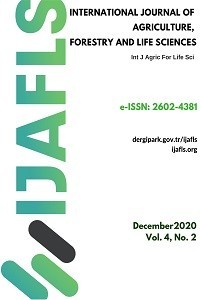The effects of grape seed flour and glucose oxidase supplementation on the some quality attributes of bread
The effects of grape seed flour and glucose oxidase supplementation on the some quality attributes of bread
Bread, grape pomace, grape seed, Narince Öküzgözü, texture,
___
- AACC International (2010). Approved Methods of Analysis of American Association- St. Paul, MN: AACCI
- Beres, C., Simas-Tosin F.F., Cabezudo I., Freitas S.P., Iacomini M., Mellinger-Silva C., Cabral M.C.L. (2016). Antioxidant dietary fibre recovery from Brazilian Pinot noir grape pomace. Food Chemistry, 201, 145-152. DOI: 10.1016/j.foodchem.2016.01.039
- Bonet, A., Rosell, C.M., Caballero, P.A., Gómez, M., Pérez-Munuera, I., Lluch, M.A. (2006). Glucose oxidase effect on dough rheology and bread quality: A study from macroscopic to molecular level. Food Chemistry, 99 (2), 408-415. DOI: 10.1016/j.foodchem.2005.07.043.
- Decamps, K., Joye, I.J., Courtin C.M., Delcour, J.A. (2012). Glucose and pyranose oxidase improve bread dough stability. Journal of Cereal Science, 55 (3), 380-384. DOI: 10.1016/j.jcs.2012.01.007.
- Elgün, A., Ertugay, Z., Certel, M. and Kotancılar, H.G. (2002). Tahıl ve Ürünlerinde Analitik Kalite Kontrolü ve Laboratuvar Uygulama Kılavuzu. Atatürk Üniversitesi Ziraat Fakültesi Ofset Tesisleri, 245s, Erzurum.
- FAO. (2019). Food and Agriculture Organization of the United Nations, Statistics.
- Gül, H., Acun, S., Şen, H., Nayır N., Türk, S. (2013). Antioxidant activity, total phenolics and some chemical properties of Öküzgözü and Narince grape pomace and grape seed flours. Journal of Food, Agriculture and Environment Vol.11 (2), 28-34.
- Gül, H., Gül, M., Aslan, S.T., Acun, S., Nayır, N., Şen H. (2017). Consumer acceptability of bread produced from by-products of wine industry. Fresenius Environmental Bulletin, 26 (11), 6924-6931.
- Gül, H., Özer, M.S., Dizlek, H. (2009). Improvement of the wheat and corn bran bread quality by using glucose oxidase and hexose oxidase. Journal of Food Quality, 32, 209-223. DOI: 10.1111/j.1745-4557.2009.00246.x
- Gül, H., Şen H. (2017). Effects of pomegranate seed flour on dough rheology and bread quality, CyTA - Journal of Food, 15:4, 622-628. DOI: 10.1080/19476337.2017.1327461.
- Hoye, C., Ross, C.F. (2011). Total phenolic content, consumer acceptance, and instrumental analysis of bread made with grape seed flour. Journal of Food Science, 76 (7), 428-436. DOI: 10.1111/j.1750-3841.2011.02324.x.
- Yayın Aralığı: Yılda 2 Sayı
- Başlangıç: 2017
- Yayıncı: Volkan OKATAN
Zana Abdalrahman JAWAD, Musa TÜRKER, Fethi Ahmet ÖZDEMİR
Recent developments of industrıal enzyme production in food biotechnology
Kenan Sinan DAYISOYLU, Burcu YEŞİLTOPRAK
Fitri RACHMAWATİ, Dewi PRAMANİK, Budi WİNARTO
Essential oil content and composition of Cotinus coggygria Scop. from Hatay, Turkey
Riza TEMİZKAN, Muhammed Ali DOĞAN, Orhan ATAKAN, Burak Alptuğ NAZLIM, Hüseyin AYVAZ
